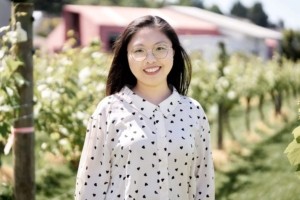
Jane Qin
In this feature we interview staff members who have been identified as Early Career Researchers. In the spotlight is Jane Qin, Wine Science Lecturer in the School of Viticulture and Wine Science.
What is your highest qualification and where and when did you finish it?
Master of Horticultural Science (in Viticulture and Oenology), Lincoln University, 2016.
What is your role at EIT and what courses do you teach?
I am a wine science lecturer and also help with viticulture courses.
- Chemistry in wine science
- Wine sensory science
- Fundamentals of wine
- Flavour farming
What areas do you specialise in?
- Wine chemistry
- Sensory science
- Grapevine physiology
What research have you been involved in either last year or this year?
To investigate chemical compounds and their contribution to mouthfeel of chardonnay wines, and how winemaking techniques could alter the mouthfeel perception of chardonnay wines.
In collaboration with Dr Ye, we have selected 17 HB chardonnay wines. We had a panel of 3 wine experts who tasted those 17 wines and further selected 8 wines that in their opinion, are good examples of HB chardonnay wines. From there, we run sensory Napping® by employing another 10 wine experts.
For my own individual project, chemical and physical analyses have been conducted and I also did a winemaking survey. At this stage, I haven’t finalised the results yet and I am still waiting for more data to come in. What I have found so far,
- Extended skin contacts and the usage of oak barrels or oak chips resulted in high phenolic content in wine.
- Wine experts who participated in Napping® are able to distinguish those phenolic wines from the others.
- Wines from the same producer must share some similarities in winemaking, based on the consensus map produced from Napping®, although the grapes were sourced from different sub-regions.
The next step is to overlay sensory descriptors, chemical data and the winemaking questionnaire onto the sensory consensus map produced from Napping®, which will help us,
- Understand the logic or sorting criteria why panellists grouped wines like that.
- Making the connections which chemical compound or a group of them may be responsible for a specific mouthfeel perception.
- Making the connections which winemaking technique could alter the mouthfeel of chardonnay wines.
How important is research to you as an academic?
Doing research helps me stay tuned. The current research that I am conducting is especially relevant with the subjects I am teaching, e.g., Sensory Science, Chemistry in Wine Science, and Fundamentals of wine. Research allows me to update my knowledge and course materials, and while teaching those courses, it sparkles my interests in doing more research.
How supportive is EIT in encouraging you to do research?
We have a regular research meeting at our school, where all researchers and technicians present ideas and suggestions. Collaboration is always encouraged. Our head of school, Sue Blackmore is especially supportive and held a symposium last year, and hopefully will have another one this year. The symposium allows us to showcase the research we did or about to conduct, pair up with others who are in the same research field, and gather ideas and suggestions.
Staff at the Research and Innovation Centre are helpful and had given me suggestions on writing up grant application, making budgets and help me to keep track of my budget.
Jadwiga at the library also helped with sourcing research literatures.
